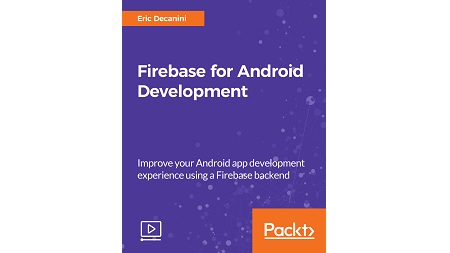
English | MP4 | AVC 1920×1080 | AAC 48KHz 2ch | 2h 34m | 839 MB
Develop real-time Firebase backends for your Android apps. Increase user engagement and build apps faster
Building a successful app needs a backend platform to store your users’ data, which is taxing and inefficient if you try to create your own. There are so many devices that would take you forever if you tried to test your app on them. You will waste time fixing bugs affecting your app and it’s almost impossible to tailor your app to each user’s needs.
This course starts by explaining the features and benefits of using Firebase as a backend. Firebase is a seamless way to connect your app to the cloud. This way, your app can access its various tools and services—for example, its databases (to create an easy backend) and its crash reporting services, to save you plenty of time debugging. This course will help you build a to-do list application that rewards users with value points for completing tasks, allowing them to reap rewards such as special features as they get more tasks done. You’ll also be able to access a PC version of the app to add and remove items, which will update on all platforms in real-time. You’ll even be able to send alerts from the PC to the Android version of the app, even if the app hasn’t yet been opened on Android, to make sure important tasks never go unchecked.
By the end of the course, you will be able to implement Firebase and its different tools and services in any app. You will be trained to think from the perspective of your users, build the right backends to support their needs, and run effective tests to make sure the features you build are successful.
This course starts by exploring what Firebase is, what it can do, and how YOU can use it to its fullest extent. You will then look at many of its different tools and services and implement them in the development phase. This course aims to increase user engagement and you will learn to keep a user-based perspective so that you know what your user’s app needs are and can, therefore, create a successful app using Firebase.
What You Will Learn
- Identify Firebase backend solutions that get your app connected to the cloud
- Build a scalable cloud database that can work in real-time as well as offline
- Create a system to validate users and allow their data to be synced across their different devices
- Store large files such as images on cloud storage connected to your database
- Leverage the power of analytics to log events and find out what features are being used most by your users
- Split users into segments to target them with push notifications they need and give them an improved in-app experience.
- Conduct different user and device tests and pinpoint the cause of bugs in your app
Table of Contents
Introduction to Firebase
1 The Course Overview
2 What Is Firebase
3 Final Project Demo
4 Environment Setup
Storing Data with the Firestore Database
5 Knowing Data Model
6 Importing Firebase Dependencies
7 Introducing Firebase Authentication
8 Getting Users Authenticated
9 Introducing Cloud Firestore
10 Storing Data with Firestore
11 Deleting List Items
12 Understanding Firestore Security Rules
Access Cloud Storage
13 Debugging Common Firebase Issues
14 Designing Our App
15 Introducing Firebase Cloud Storage
16 Uploading Images to the Cloud
17 Downloading and Displaying Images
18 Storage Security Rules
Learning about Our Users with Analytics
19 Introducing Firebase Analytics
20 Visiting Our Analytics Dashboard
21 Logging Key Events
22 What Is User Segmentation
23 Defining User Segments
Reaching Out to Users with Cloud Messaging
24 Introducing Firebase Cloud Messaging
25 Sending Messages Through the Console
26 Different Applications of Cloud Messaging
Tailoring In-App Experience with Remote Config
27 Introducing Firebase Remote Config
28 Setting, Getting, and Fetching Server-Side Parameters
29 Exploring Remote Config Use Cases
Responding to Key Events with Cloud Functions
30 Introducing Firebase Cloud Functions
31 Trigger – User’s First Log In
32 Execution – Send Them a Welcome Message
Effective Testing and Debugging
33 Introducing Firebase Crashlytics
34 Setting Up Crashlytics
35 Customizing Crash Reports
36 Introducing Firebase Test Lab
37 Simultaneous Device Robo Testing
38 Conducting A B Tests
39 Our Finished Value List
Resolve the captcha to access the links!